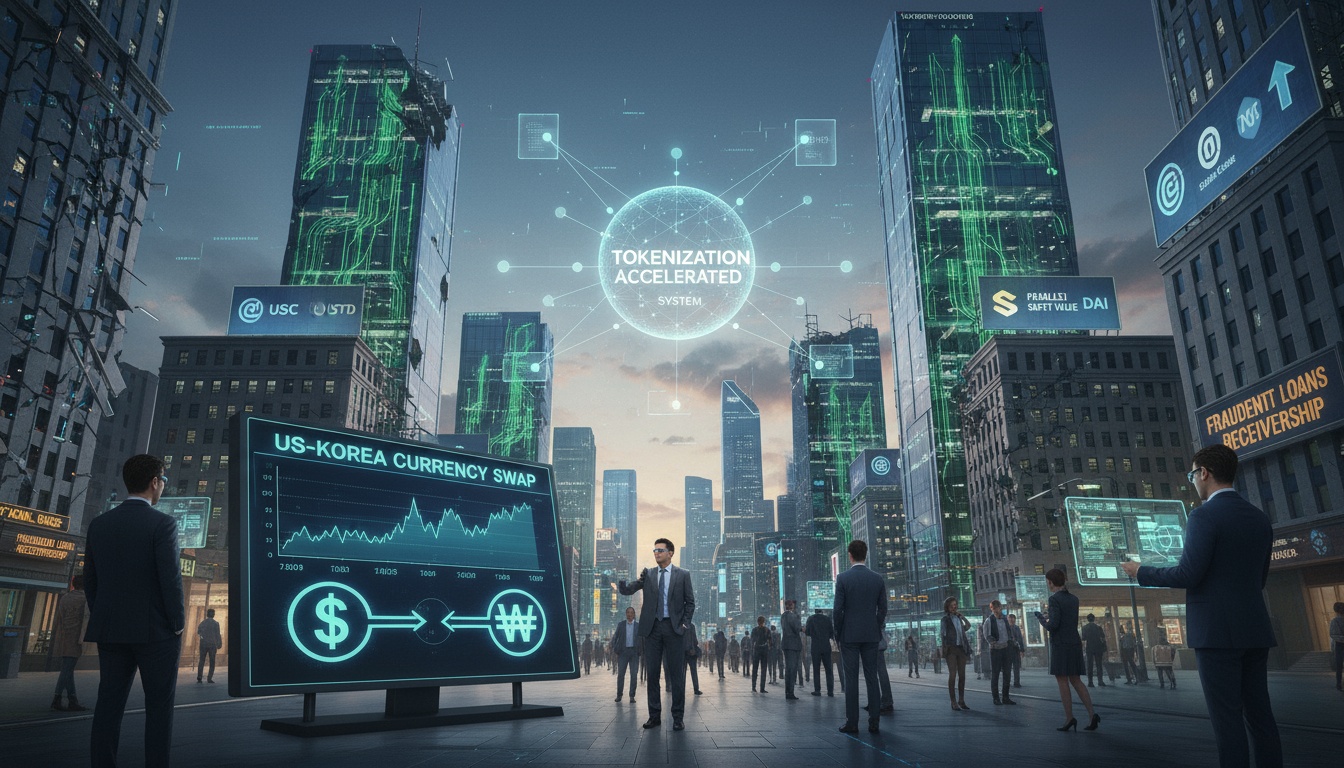● Bank Fraud Wave, Dollar Shield or Currency Crash
[Immediate Analysis] Differentiating U.S. Regional Bank Failures from Systemic Risks, A Realistic Scenario for Korea-U.S. Currency Swap, and a Comprehensive Overview from Exchange Rate Outlook to AI and Stablecoin Wars
Today’s article contains three key points.
First, it outlines in a news format that the essence of the U.S. regional bank failure issue lies in ‘fraudulent loans’ and individual cases, and that it is structurally different from the SVB incident.
Second, it presents the possibility that the Korea-U.S. currency swap may be arranged not through the Fed’s permanent swap lines but via a U.S. Treasury–Bank of Korea line, along with realistic scale considerations and exchange rate outlook scenarios.
Third, it connects the core structural changes in the financial market—such as bank-led stablecoins, tokenization of RWAs, and AI-based risk management—to the trends of the Fourth Industrial Revolution and AI.
U.S. Regional Bank Failures: What Is Fact and What Is Fear?
Recently, several U.S. regional banks have experienced losses due to fraudulent activities revealed in commercial real estate and investment fund-related loans.
This issue bears the strong characteristics of a ‘fraudulent event’ with false statements and contract breaches by specific borrowers, leading to a sharp decline in individual bank stocks, but with limited transmission to systemic risk.
The White House National Economic Council has stated that this is “a category that can be addressed proactively,” and global credit rating agencies are emphasizing the “low possibility of contagion.”
However, warnings similar to the ‘cockroach theory’ espoused by CEOs of large banks—that additional cases of fraud could be discovered—remain valid.
This suggests that rather than a crisis, it is more a matter of “cleaning up existing risks.”
How Is This Different from the SVB Incident?
The SVB case was a “maturity mismatch/liquidity” incident where a bank run converted unrealized losses into realized losses amid a sharp rise in interest rates, which significantly increased the valuation losses in Treasuries and MBS.
The current regional bank issue is driven by individual credit cases related to ‘fraudulent loans’ rather than the structure of interest rates or maturity mismatches.
It is not solely concentrated on tech startups with weak deposit bases, nor has it triggered a widespread bank run.
Therefore, it is not a factor that threatens the overall financial stability of the U.S. economy.
The Resilience of the Financial Market as Shown by the Big 6 Banks’ Earnings
The third-quarter earnings of the U.S. Big 6 banks have shown improvements in net income, net interest income, and investment banking fees.
With a recovery in deal cycles such as M&A and IPOs, investment banking fees have increased significantly compared to the previous year, and loan loss provisions have generally remained stable.
The easing of regulatory burdens combined with improved liquidity conditions increases expectations for ROE improvements through the end of the year.
The robust fundamentals of the major banks are evidence that the risk of systemic contagion is low.
A Realistic Structure and Scale for the Korea-U.S. Currency Swap
The Fed’s permanent swap lines are limited to currencies of the major reserve countries, making Korea’s inclusion unlikely.
In the past, during the 2008 and 2020 crises, the Korea-U.S. swap was arranged temporarily between the Fed and the Bank of Korea under crisis conditions.
In a phase without a crisis like the present, a similar liquidity backstop or guarantee-based cooperative framework between the U.S. Treasury and the Bank of Korea is more realistic.
Based on the IMF’s Adequate Reserve Assessment (ARA) metric, there is a gap between Korea’s foreign exchange reserves of approximately USD 420 billion and the recommended level of about USD 470 billion.
Thus, a temporary swap/backstop of around USD 50 billion is realistically being discussed.
The key point is that this line serves as an “exchange rate shock absorber” rather than a source of funds for external investment.
That is, it is insurance to stabilize the exchange rate outlook, not immediate cash execution.
Understanding the USD 350 Billion U.S. Investment Package
The much-discussed USD 350 billion package is virtually impossible to implement solely through “direct investment.”
The realistic structure will likely involve a mix of guarantees, loans, and equity investments, SPV design, and layering with domestic policy finance guarantees.
The division of profits and decision-making power are key negotiation points, and past precedents in U.S.-Japan strategic investment processes show that a U.S. committee typically recommends proposals to the president, with final selection and notification following a top-down structure.
Japan executed its plan by attracting private dollars through equity, loans, and guarantees from institutions like JBIC and trade insurance.
This precedent suggests that in Korea too, “the decision-making leadership may be limited,” in reality.
Exchange Rate and the Dilemma of the Bank of Korea: Rate Cuts or Defense?
If the swap/backstop is announced, the won is likely to appreciate, which could lower import price pressures.
In the absence of such measures, the won may weaken with increased volatility, reinforcing the sentiment for exchange rate defense.
The Bank of Korea is tempted by rate cuts amid slower growth and stresses in the real estate and project financing markets, but concerns over the exchange rate and overheating of the housing market necessitate cautious pace.
Ultimately, the timing of rate cuts will likely be determined by the U.S. inflation and interest rate trajectory, and whether the swap is successfully implemented.
AI and the Fourth Industrial Revolution Perspective: The Stablecoin Wars and Digital Transformation of Banks
Joint bank-issued stablecoins, tokenized deposits, and tokenization of RWAs are mega-trends that will transform the financial infrastructure layer by 2025–2026.
If banks control the issuance and settlement networks directly, they could have an overwhelming advantage in terms of stablecoin credibility and regulatory compliance.
Artificial intelligence will advance real-time risk management by automating transaction anomaly detection, fraudulent loan identification, and liquidity stress tests.
The recent fraudulent losses at regional banks could be reduced if AI-based KYC and transaction pattern analysis are fully implemented.
From an investor’s perspective, a bank’s digital asset strategy and its AI risk stack will be premium valuation factors.
This Week’s Investment Checklist
- Check for official communications regarding the negotiation of the swap/backstop, including scale, maturity, and activation conditions.
- Monitor whether the USD/KRW exchange rate settles in the 1,300 won range, as this will affect the sensitivity of export versus domestic stocks.
- Watch for any changes in language at the Bank of Korea’s monetary policy meeting regarding the balance between growth and exchange rate stability.
- If U.S. CPI, employment, and consumer indicators confirm the trajectory for rate cuts, the preference for risky assets could expand.
- The trends in investment banking fees and loan loss provisions of major U.S. banks are key indicators of the global financial market risk premium.
- Keep a close watch on news flow regarding bank pilot programs for stablecoins/tokenization, regulatory guidelines, and planned investments in artificial intelligence.
The Most Important Insights Not Commonly Mentioned Elsewhere
- The core of the current regional bank issue is an individual event centered on fraudulent loans, which is different from the SVB-type maturity mismatch crisis.
- The realistic approach is not the Fed’s permanent swap but rather a temporary backstop coordinated by the U.S. Treasury and the Bank of Korea, with a reasonable scale of around USD 50 billion based on the IMF adequacy gap.
- The swap functions as exchange rate insurance rather than a fund for external investments.
- The USD 350 billion U.S. investment package will likely lean towards a higher proportion of guarantees and loans, with decision-making power predominantly on the U.S. side.
- The emergence of bank-led stablecoins, RWA tokenization, and advanced AI risk management will fundamentally transform the financial landscape.
Conclusion: It Is Time to Bet on Structural Transformation Rather Than Excessive Fear
The strength of the U.S. financial system is confirmed by the robust earnings of the Big 6 banks, and the regional bank issues are more about cleaning up risks than posing systemic threats.
If the Korea-U.S. swap is executed, the exchange rate outlook will lean towards stability, thereby broadening the policy options for the Bank of Korea.
The next cycle’s winners will be the financial institutions and industries that are prepared for digital assets and artificial intelligence.
Investors should consider the volatility phase as an opportunity to rebalance towards structural transformation.
< Summary >
The regional bank failures are individual incidents centered on fraudulent events, differing from an SVB-type systemic crisis.
The strong earnings of the Big 6 banks confirm that the financial market remains resilient.
The realistic Korea-U.S. swap will be a temporary backstop arranged by the U.S. Treasury and the Bank of Korea, with a reasonable scale of around USD 50 billion based on the IMF adequacy gap.
The swap is exchange rate insurance rather than a source of funds for external investment.
AI, stablecoins, and RWA tokenization will be key drivers of growth in the next cycle.
[Related Articles…]
2025 Exchange Rate Outlook: The Scenario for USD/KRW to Settle at 1,300 Won
Stablecoin Regulations and Banks’ Digital Asset Strategies
*Source: [ 경제 읽어주는 남자(김광석TV) ]
– [LIVE] (1)미국 지역은행 연쇄부실 이어지나? (2)한미 통화스와프 체결될까? [즉시분석]


